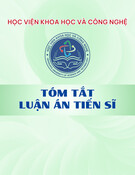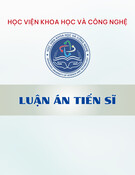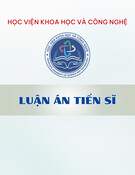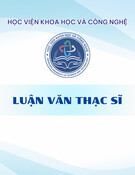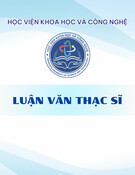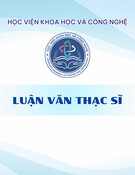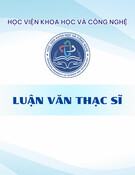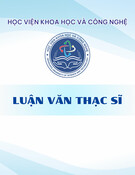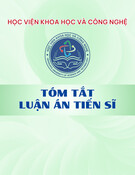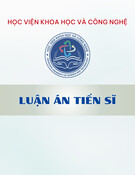
1
MINISTRY OF EDUCATION
AND TRAINING
VIETNAM ACADEMY OF
SCIENCE AND TECHNOLOGY
GRADUATE UNIVERSITY SCIENCE AND TECHNOLOGY
………***……….
VU THI MAI
STUDY ON THE PRODUCTION OF MODIFIED BIOCHAR AND
ACTIVATED CARBON DERIVED FROM CORNCOB AND THEIR
APPLICATION IN AMMONIUM REMOVAL
FROM DOMESTIC WATER
Major: Environmental Engineering
Code: 62 52 03 20
SUMARY OF DOCTORAL THESIS IN
ENVORONMET TECHNOLOGY
Hanoi - 2018

2
The thesis has been completed at: Institute for Environemtal
Technology – Graduate university science and technology – Vietnam
Academy of Science and Technology
Science supervisor: 1.Assoc.Prof.Dr Trinh Van Tuyen
2. Assoc.Prof.Dr Doan Dinh Phuong
Reviewer 1: ……………………………………………………
……………………………………………………
Reviewer 2: ……………………………………………………
……………………………………………………
Reviewer 3: ……………………………………………………
……………………………………………………
The thesis was defended at National level Council of Thesis Assessment
held at Graduate University of Science and Technology – Vietnam
Academy of Science and Technology at….on……
Thesis can be futher referred at:
-The Library of Graduate University of Science and Technology
-National Library of Vietnam

3
INTRODUCTION
1. Background
In recent years, groundwater levels in Vietnam have been
declining in quantity and quality due to the impacts of climate change
and exploitation for economic. Vietnam has abundant surface and
ground water resources (the average total runoff is 848 km3/year);
however, approximately 6 million Hanoi inhabitants receive 80% of
their drinking water from groundwater. Excessive presence of
ammonium could negatively affect the quality of groundwater and
surface water. Households might suffer potential health risks from
using directly water resources with uncontrolled quality.
In some areas in Vietnam, groundwater often contains a higher
level of iron, manganese, arsenic, ammonium concentrations than the
allowable limitation. According to previous reports, the presence of
ammonium concentration in groundwater in some areas exceeded the
surface water quality standards in Vietnam. Such typical areas are in
the northern (i.e., Vinh Phuc, Bac Ninh, Hai Duong, Hung Yen, Hanoi
provinces) and the south (i.e., Ho Chi Minh City) of Vietnam.
Numerous techniques have been applied to remove ammonium
ions from environmental bodies, such as ion exchange, membrane
technology, adsorption, nitrification-denitrification processes,
chemical precipitation, and electrochemical separation. Among these
methods, adsorption is considered an effective, inexpensive, and
simple technique for removing ammonium from water media.
Carbonaceous porous materials—activated carbon and biochar—have
been acknowledged as promising adsorbents to remove the various
kinds of pollutants (i.e., potentially toxic metals and dyes) from

4
environmental water. According to the literature, however, pristine
activated carbon (AC) often exhibits its poor maximum adsorption
capacity toward ammonium (i.e., 0.5–5.4 mg/g). Therefore, it is
necessary to apply further treatment or modification process to the
surface of AC in order to enhance its adsorption capacity to
ammonium.
According to Statistical Yearbook of Vienam 2015, the planted
area and maize production in Hanoi were approximately 21,100 ha and
102,300 tons, while the corresponding data for the whole country were
1,179,300 ha and 5,281,000 tons, respectively. Therefore, corncob
wastes can be considered an abundant, renewable, and low-cost
byproduct to prepare biochar and AC.
Therefore, the study on “Study on the production of modified
biochar and activated carbon derived from corncob and their
application in ammonium removal from domestic water” was
conducted.
2. Objectives of this dissertation
□ Develop the optimal preparation procedure of modified
biochar and activated carbon derived from an agricultural by-
product, such as corncob wastes;
□ Investigate the physical and chemical properties of
modified biochar and activated carbon;
□ Apply modified biochar and activated carbon in removal
of ammonium from synthesised and real water under batch and
column experiments;
□ Propose adsorption mechanism.
4. The composition of the thesis

5
The thesis consists of 101 pages with 38 tables, 50 images, 123
references. The thesis was composed of 3 pages, 37 pages of literature
review, 15 pages of research subjects and methods, 44 pages of
research results and discussion, conclusion of 2 pages.
THESIS CONTENT
CHAPTER 1: LITERATURE REVIEW
Ammonium contamination in ground water, methods of
ammonium treatment, overview of methods of biochar production,
modification methods in terms of biochar, activated carbon and
application of biochar as organic adsorbent, heavy metals and
ammonium treatment in water have been summarized.
The research results show that: The researches focus on the
application of biochar, modified activated carbon for ammonium
treatment in water but there have not many researches focusing on the
biochar surface modification for the adsorption of ammonium in
water. The use of corncob to produce modified biochar for the
adsorption of ammonium has not been investigated.
Based on the review of the research materials, the thesis will
focus on the following issues:
- Providing optimum conditions for the production of modified
biochar from corncob and modified activated carbon to enhance the
ammonium adsorption capacity.
- Determining the characteristics of dynamics and
thermodynamics of ammonium adsorption in the water of the
materials on the scale of batch adsorption and adsorption on the
column.

